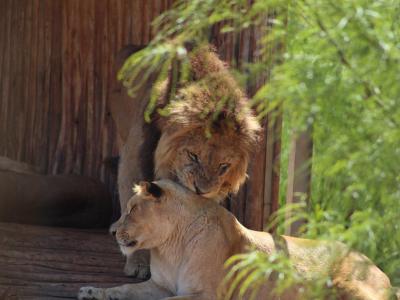
Rabat Zoo, Rabat
The Rabat Zoo is one of Morocco’s most prominent wildlife conservation centers. Originally established in 1973 as the Temara Zoo, it was initially designed to house lions that once resided in the Royal Palace, believed to be descendants of the now-extinct Barbary lion. Over the years, the zoo has evolved into a modern facility dedicated to wildlife preservation, research, and public education.
Following a significant renovation initiated by King Mohammed VI in 2008, the zoo reopened in its transformed state in 2012, under the patronage of Prince Moulay Hassan. The reimagined Rabat Zoo now emphasizes semi-freedom environments, allowing animals to inhabit spaces that closely resemble their natural ecosystems.
Home to over 1,800 animals across nearly 180 species, the zoo is particularly renowned for its Atlas Lion Conservation Program, boasting the largest captive population of these lions in the world (40 specimens as of October 2024). The Atlas lion, considered extinct in the wild, remains a key focus of the zoo’s conservation initiatives.
Beyond its role as a zoological park, the Rabat Zoo also houses a paleontological museum, offering visitors a deep dive into Morocco’s prehistoric wildlife history, dating back to the Tertiary and Quaternary eras (between 2.5 million and 7,000 years ago). Through fossil exhibits and scientific films, the museum raises awareness about the importance of protecting Morocco’s animal heritage.
The zoo is actively involved in over 22 conservation programs, with eight species currently part of a reintroduction initiative aimed at restoring them to their natural habitats. This includes five species that are extinct in the wild in Morocco, such as the Addax, Bald Ibis, Dorcas Gazelle, and Barbary Sheep. In early 2024 alone, the zoo recorded over 70 births of endangered Moroccan and African species, reinforcing its commitment to sustainable breeding programs and biodiversity restoration.
With its blend of conservation efforts, educational initiatives, and immersive exhibits, Rabat Zoo stands as one of the most visited attractions in the Moroccan capital. It continues to play a crucial role in wildlife preservation, ensuring that future generations can appreciate and protect the diverse fauna of Morocco and beyond.
Following a significant renovation initiated by King Mohammed VI in 2008, the zoo reopened in its transformed state in 2012, under the patronage of Prince Moulay Hassan. The reimagined Rabat Zoo now emphasizes semi-freedom environments, allowing animals to inhabit spaces that closely resemble their natural ecosystems.
Home to over 1,800 animals across nearly 180 species, the zoo is particularly renowned for its Atlas Lion Conservation Program, boasting the largest captive population of these lions in the world (40 specimens as of October 2024). The Atlas lion, considered extinct in the wild, remains a key focus of the zoo’s conservation initiatives.
Beyond its role as a zoological park, the Rabat Zoo also houses a paleontological museum, offering visitors a deep dive into Morocco’s prehistoric wildlife history, dating back to the Tertiary and Quaternary eras (between 2.5 million and 7,000 years ago). Through fossil exhibits and scientific films, the museum raises awareness about the importance of protecting Morocco’s animal heritage.
The zoo is actively involved in over 22 conservation programs, with eight species currently part of a reintroduction initiative aimed at restoring them to their natural habitats. This includes five species that are extinct in the wild in Morocco, such as the Addax, Bald Ibis, Dorcas Gazelle, and Barbary Sheep. In early 2024 alone, the zoo recorded over 70 births of endangered Moroccan and African species, reinforcing its commitment to sustainable breeding programs and biodiversity restoration.
With its blend of conservation efforts, educational initiatives, and immersive exhibits, Rabat Zoo stands as one of the most visited attractions in the Moroccan capital. It continues to play a crucial role in wildlife preservation, ensuring that future generations can appreciate and protect the diverse fauna of Morocco and beyond.
Want to visit this sight? Check out these Self-Guided Walking Tours in Rabat. Alternatively, you can download the mobile app "GPSmyCity: Walks in 1K+ Cities" from Apple App Store or Google Play Store. The app turns your mobile device to a personal tour guide and it works offline, so no data plan is needed when traveling abroad.
Rabat Zoo on Map












Sight Name: Rabat Zoo
Sight Location: Rabat, Morocco (See walking tours in Rabat)
Sight Type: Park/Outdoor
Sight Location: Rabat, Morocco (See walking tours in Rabat)
Sight Type: Park/Outdoor
Walking Tours in Rabat, Morocco
Create Your Own Walk in Rabat
Creating your own self-guided walk in Rabat is easy and fun. Choose the city attractions that you want to see and a walk route map will be created just for you. You can even set your hotel as the start point of the walk.
Rabat Shopping Walk
Rabat is heaven for those who love shopping. Indeed, the abundance of shopping opportunities – traditional markets and shopping streets – in this city gives no reason to doubt that. There you can find all kinds of oriental delights you can possibly think of.
One of Rabat's top shopping destinations is Consuls Street (rue des Consuls). Steeped in a 500-year history, this street houses... view more
Tour Duration: 1 Hour(s)
Travel Distance: 1.0 Km or 0.6 Miles
One of Rabat's top shopping destinations is Consuls Street (rue des Consuls). Steeped in a 500-year history, this street houses... view more
Tour Duration: 1 Hour(s)
Travel Distance: 1.0 Km or 0.6 Miles
Rabat Introduction Walking Tour
Resting on the shores of the Bouregreg River and Atlantic Ocean, the capital city of Morocco, Rabat, is known for its picturesque natural surroundings, much as for its man-made beauty manifested in a mix of old and new architecture (featuring Islamic and French-colonial styles), abundance of mosques and historic monuments. The Medina (Old City) of Rabat is a World Heritage Site.
Rabat was... view more
Tour Duration: 1 Hour(s)
Travel Distance: 2.0 Km or 1.2 Miles
Rabat was... view more
Tour Duration: 1 Hour(s)
Travel Distance: 2.0 Km or 1.2 Miles


